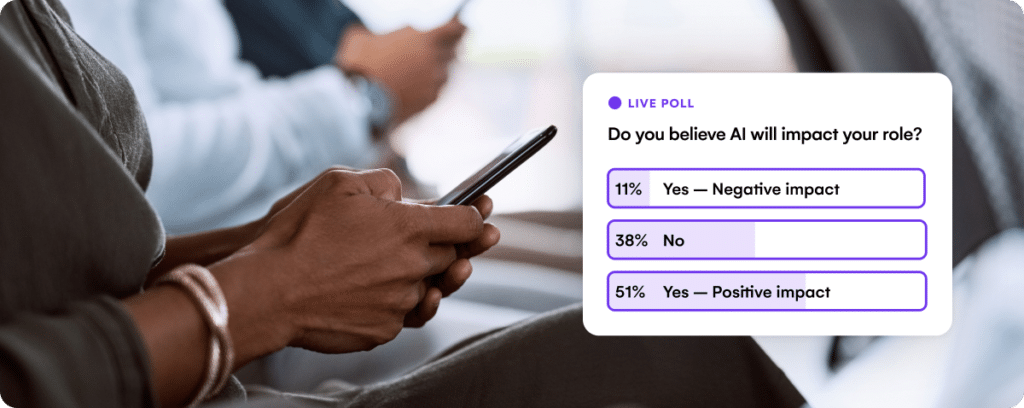
Many associations run events year after year without a clear benchmark for success. Measuring satisfaction alone – like attendee ratings or speaker feedback – offers only a surface-level view. To truly understand the impact of an event, association leaders need access to smart, strategic data that reveals what worked, what didn’t, and what’s worth doing again.
A clear, outcome-focused measurement plan gives you more than just post-event insights. It helps optimize budgets, improve profitability, and drive sustainable growth across your association event portfolio. Whether in person, virtual, or hybrid, events should be evaluated not just on how they felt, but on the value they delivered to your members, sponsors, and your bottom line.
In this EventsAir guide, we share a straightforward way to measure success. We cover how to set goals, choose the right metrics, and collect and use data with tools like EventsAir to support smarter decisions.
What does it mean to measure association event success?
Measuring association event success means looking at how well the event met its main goals. These might include engaging members, sharing knowledge, generating revenue, or helping sponsors and partners connect with leads.
Success is measured using data like attendance, session participation, ROIs, and what people do after the event. These numbers help paint a clearer picture of the event’s impact and the value it delivered.
This approach works for all event types: in-person, virtual, or a mix of both. Measuring success the same way each time makes it easier to track progress, compare results, and make changes that improve the experience for both members and stakeholders.
Why is it important to measure association event success?
Measuring the success of association events is key to making smart decisions and shaping long-term plans. Here are five reasons why it should be a priority:
- Show return on investment: Comparing event costs with outcomes like revenue, membership growth, and sponsor engagement helps justify spending and plan future budgets. This also enables your team to set a benchmark for future success and continuously improve and adjust your events where needed.
- Improve member engagement: Reviewing participation and feedback highlights what members value, helping shape more relevant and engaging events.
- Support strategic planning: Event data can guide bigger-picture decisions, keeping organizational goals in sync with member needs.
- Use resources effectively: Knowing what delivers value helps allocate time, budget, and staff where they matter most, irrespective of the event format.
- Build stronger relationships: Transparent reporting earns trust from members, sponsors, and partners, encouraging long-term support.
Your 5-step guide to measuring association event success
Step 1. Set specific event objectives
Before choosing metrics, define what success looks like for your association. Broad goals like “engagement” or “growth” are not enough.
Start by aligning your event goals with your association’s overall priorities. Are you focused on member retention, lead generation, increased attendance, or policy influence?
Make your objectives measurable from the start. Clarity here sets the foundation for meaningful evaluation later.
It also helps to break down goals by stakeholder group:
- Members: Knowledge gained, networking opportunities, content quality
- Sponsors: Number of leads, brand visibility
- Leadership: Strategic alignment, financial return, member conversion or attrition
These categories guide both event planning and post-event analysis. Each objective should connect to a specific outcome.
Step 2. Select Relevant KPIs
Once objectives are set, the next step is to define KPIs that clearly reflect progress. Depending on your objectives, there are usually a handful of indicators to measure here.
To get the full list, check our article on Association Success Metrics for Member Events.
Trying to see which KPIs to choose? Use this quick filter:
- Relevant: Tied to a specific objective
- Measurable: Supported by reliable data
- Actionable: Leads to decisions or adjustments
Also, when choosing your KPIs, avoid common mistakes like tracking too many, chasing vanity metrics, or picking what’s easiest to measure. If a metric doesn’t help you evaluate success or guide future action, it’s just noise. Always remember that fewer, sharper metrics deliver clearer insights.
Step 3. Collect and analyze data
Accurate measurement starts with structured, timely data collection. Set the foundation early by designing your registration process to capture key attendee details like job role, organization, and session interests.
During the event, use tools to track engagement as it happens. This includes:
- Mobile apps: Monitor app usage, session check-ins, and interaction
- RFID badges: Track booth visits and session attendance
- Live polls and Q&A: Gauge real-time interest and participation

After the event, send out surveys to collect qualitative feedback. Use consistent, standardized questions to make analysis easier and more reliable.
To get a complete picture, combine:
- Quantitative data: Attendance numbers, engagement rates, click-throughs
- Qualitative insights: Survey feedback, comments, open-ended responses
Bringing these data types together gives you a more complete view of event performance and helps you spot wins and areas for improvement in analysis.
TIP: Check our Event Reporting & Analysis guide for additional insights.
Step 4. Evaluate and benchmark performance
Once your data is collected and analyzed, the next step is to evaluate how well the association event met its goals. Start by comparing your results to the objectives you set early on. This helps you pinpoint what worked and where there’s room to improve.
Benchmarking adds valuable context. For example, a 15% increase in member attendance over last year shows progress, while a drop in session engagement may signal a need to revisit content strategy.
Use dashboards and visual reports to spot trends and outliers more easily. This helps track performance over time and across different event formats.
Key considerations include:
- Trend analysis: Look for patterns in attendance, engagement, and feedback
- Goal alignment: Measure how well outcomes match your original objectives
- Stakeholder reporting: Create clear, focused summaries to share with key stakeholders
Consistent evaluation and benchmarking support better decision making and drive ongoing improvements year after year.
Step 5. Report findings and implement feedback
Once your association event data is analyzed, share a clear summary of the results. Focus on key outcomes, trends, and areas for improvement. Use visuals like charts and dashboards to make the data easy to understand.
To maintain transparency and build trust, the report should be distributed to stakeholders soon after the event. It should include specific, actionable recommendations.
Here’s how you can turn feedback into improvements:
- Prioritize issues: Focus on the most impactful areas first
- Assign responsibilities: Make sure team members are accountable for the next steps
- Set timelines: Define deadlines to keep progress on track
Revisit these actions regularly. A structured follow-up process helps improve future association events and shows that attendee and stakeholder input is valued.
How EventsAir helps measure your association event success
At EventsAir, we provide a complete set of tools to help associations track and evaluate event performance with confidence. With access to over 150 built-in reports and customizable dashboards, you can monitor data in real time and make informed decisions at every stage.

Key features include:
- Extensive reporting library: Track key metrics such as registrations, sponsorships, accommodations, and finances.
- Custom dashboards: Build dashboards that focus on the data your team values most, updated in real time.
- Flexible export options: Export full or partial datasets in Excel, PDF, CSV, and more – securely and efficiently.
Post-event data collection, analysis, and scalability
After your association event, we help you extend its value through powerful content sharing and post-event analysis tools. You can easily run detailed reports and gather feedback to understand engagement and satisfaction better.
Our post-event tools include:
- Detailed event reporting: Access reports on attendance, financials, access logs, sponsors, etc.
- Feedback collection: Distribute surveys and polls to capture valuable attendee input.
- Instant event cloning: Save time, stay consistent, and scale smarter, every time.
- On-demand content delivery: Offer access to recorded sessions, monetize new audiences, and track content engagement.
EventsAir’s impact at WTC 2023
At the World Tunnel Congress 2023, CONVIN S.A. used EventsAir to manage registration, abstracts, data, and engagement for 2,000 participants from 66 countries. Our all-in-one event management platform saved time, reduced errors, and helped measure success through real-time insights and custom reports.
Strategic best practices for measuring association event success
- Assign ownership early: Define who is responsible for measurement from the start. Align internal teams on what will be tracked, how it supports association goals, and how results will be used post-event.
- Cut low-value metrics: Review your data strategy regularly. Remove metrics that don’t inform decisions about member value, sponsor outcomes, or program goals. Focus on data that leads to action.
- Use real-time analytics: Monitor key metrics during the event. Real-time data helps you adjust engagement tactics, session flow, or support channels while the event is live.
- Benchmark against industry standards: Go beyond internal comparisons. Use association-specific benchmarks, such as member engagement rates or sponsor ROI, to see how your events perform in context.
- Tailor reporting to stakeholders: Customize reporting for each audience. Board members may want to see strategic alignment and ROI, sponsors care about visibility and leads, and members focus on value.
- Support continuous improvement: Treat every event as a chance to learn. Use what you gather to fine-tune programming, engagement, and strategy over time.
Measure what matters, improve what counts
Measuring association event success goes beyond tracking numbers. It’s about connecting data to goals and using insights to make better decisions. When done right, measurement becomes a repeatable process that drives stronger outcomes. That’s where EventsAir makes a difference.
Our platform gives associations the tools they need to track real-time data, build custom reports, and gather meaningful feedback after each event. From registration through post-event follow-up, we support the entire measurement process with accuracy and ease.
Request a demo today to experience how EventsAir can turn every association event into a smarter, more strategic experience!
Associations | Event Data & Analytics
See EventsAir in action
Discover why 12,000+ event professionals trust EventsAir to deliver effortless events, every time.




